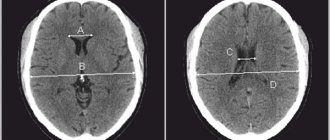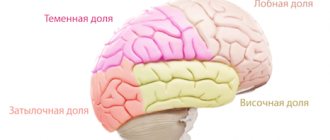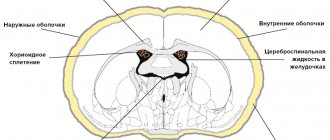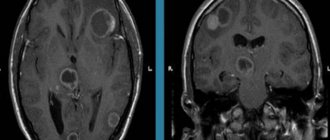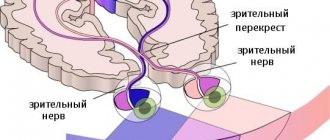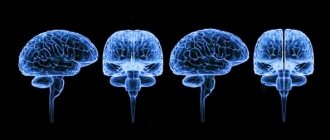"Split Brain"
The separation of the hemispheres doubles consciousness. Sperry said: “In other words, each hemisphere seems to have its own independent and private sensations, its own perceptions, its own concepts, and its own motivating impulses.”
How does a split-brain person function after surgery?
Having two "brains" in one body can create a serious dilemma. When one split-brain patient got dressed, he would sometimes pull his trousers down with one hand and pull them up with the other. One day this patient grabbed his wife with his left hand and shook her violently. His right hand gallantly came to the woman's aid and intercepted his militant left hand. Although such conflicts can occur, it is much more common for split-brain patients to behave completely normally. The reason here is that both sides of the brain have almost the same experience at the same point in time. Moreover, if conflict arises, one half usually prevails over the other.
Split-brain effects are most easily observed during special tests. For example, we could flash a dollar symbol to the right side of the brain of a patient named Tom. And direct the image of the question mark to the left half of his brain. Next, Tom is asked to draw what he sees, using his left hand blindly. The left hand draws the dollar symbol. If Tom is then asked to point with his right hand to a picture of what his “invisible” left hand has drawn, he will point to the question mark. In short, in a split-brain person, one hemisphere may not know what is happening in the other. This is an extreme case of the situation when “the right hand does not rise, what is the left doing?
LECTURES ON NEUROPSYCHOLOGY: Lecture No. 2 5/5 (2)
Lecture No. 2
1. The problem of interhemispheric brain asymmetry and interhemispheric interaction 2. Development of the theory of interhemispheric brain asymmetry 3. Directions in the study of the problem of interhemispheric brain asymmetry. 4. processes of interhemispheric interaction 5. formation of pair work of hemispheres in ontogenesis
1. The problem of interhemispheric asymmetry and interhemispheric interaction is one of the most pressing in modern natural science. Currently, it is being developed by various neurosciences: neuroanatomy, neurophysiology, neurobiology, etc. It is also being studied very productively by neuropsychology. Local brain lesions as the main model for neuropsychological research offer unique opportunities to study this problem in humans.
Interhemispheric asymmetry is one of the fundamental patterns of brain function not only in humans, but also in animals. However, despite the relatively long history of studying this problem (its beginning can be dated back to 1861, when P. Broca discovered the “center” of speech motor activity in the left hemisphere of the brain) and the huge number of modern publications on its various aspects, there is no complete theory , which explains the functional asymmetry of the cerebral hemispheres and takes into account the action of both genetic and sociocultural factors in its formation, does not yet exist. The actual data obtained from various clinical and experimental materials are numerous and often contradictory. We can say that the accumulation of factual material on this problem is clearly ahead of its theoretical understanding.
Currently, many facts have been obtained about the disparity of the left and right hemispheres of the brain according to various indicators. These are anatomical and physiological data, and materials from observations of patients with similar lesions in the left and right hemispheres. Anatomical data indicate that even in animals (rats, cats, monkeys, etc.) there are anatomical differences in the structure of the left and right hemispheres of the brain. They are most distinct in the temporal region.
The following structural differences in the fields of the right and left hemispheres were discovered: 1. ♦ the total area of the inferior frontal gyrus (45th field) in right-handed people on the left is greater than on the right; 2. ♦ in the inferior parietal areas of the cortex (39th and 40th fields) on the left, the size of the cortex in the depth of the sulci is increased; 3. ♦ the insular region on the left is larger than on the right; 4. ♦ the posterior opercular zone (or Wernicke's zone) in the temporal region in the left hemisphere is one third larger than in the right; 5. ♦ there is a morphological asymmetry of the vessels of the middle cerebral artery in the left and right hemispheres; 6. ♦ the length of the left hemisphere exceeds the length of the right in more than 54% of cases; 7. ♦ the degree of vertical ordering of the diameter of the cortex, primarily layer III (rich in associative connections), is significantly higher in the cortical fields of the human brain compared to higher primates and significantly higher in the inferior frontal and temporal regions of the left hemisphere compared to the right.
Studying the structure of human cortical fields at the neural level also revealed lateral differences. It has been established that: ♦ the sizes of neurons of layers III and IV in the 44th and 45th fields in the left hemisphere are larger than in the right; ♦ the size of Betz's giant pyramidal cells in layer V of the 4th motor field in the left hemisphere also exceeds the size of these neurons in the right hemisphere.
There is evidence of morphological differences in the organization of the left and right thalami, as well as the left and right caudate nuclei. A particularly clear asymmetry of structure is observed in the nuclei of the thalamus associated with speech functions (for example, in the posterior lateral nucleus, which has projections to the posterior temporoparietal and inferior parietal cortex).
Thus, most researchers are convinced of the existence of a morphological basis for functional asymmetry of the brain, which is the structural basis of functional differences.
Interhemispheric brain asymmetry is also the subject of numerous physiological studies. Many authors study EEG manifestations of functional interhemispheric brain asymmetry both at rest and during mental activity. When studying interhemispheric differences in EEG at rest, some researchers note a greater severity of depression of the alpha rhythm in the left hemisphere compared to the right, while others consider the alpha components of the EEG spectrum to be relatively symmetrical. However, according to many authors, during intellectual activity, interhemispheric asymmetry in terms of alpha rhythm intensifies. Most authors argue that during intellectual stress, the alpha rhythm in amplitude, index, or total energy is less pronounced in the left hemisphere than in the right. Healthy subjects exhibit different patterns of interhemispheric asymmetry (in terms of alpha and beta rhythms) when performing different types of activity.
An important place in physiological studies of the problem of functional asymmetry of the hemispheres is occupied by the method of recording evoked potentials (EP). EPs in the posterior parts of the right hemisphere are ahead in time of EPs in the same parts of the left hemisphere. This is regarded as evidence of primary visuospatial analysis of stimuli in the right hemisphere. The level of interhemispheric EP asymmetry (all other things being equal) depends on the nature of the stimulus and the area of response registration: when both verbal and spatial-structural stimuli are presented, EP asymmetry is maximally expressed in the temporal areas of the cortex. Asymmetry of visual EPs to complex stimuli (object images superimposed on each other) was found in the parieto-occipital and premotor areas of the brain, and with tasks difficult for the subject, the degree of EP asymmetry increases.
The asymmetry of bioelectrical activity of the left and right hemispheres of the brain is currently being studied in various scientific centers using the following new modern methods: ♦ method of measuring local cerebral blood flow; ♦ tomographic methods (positron emission, magnetic resonance imaging, etc.); ♦ thermoencephaloscopy method and a number of others.
The data obtained by modern psychophysiology indicate that the left-right asymmetry of biopotentials is characteristic of the norm and manifests itself especially clearly in conditions of mental activity. The asymmetry of biopotentials is a regional property and depends on the nature of the activity performed. There is an unconditional connection between the type and degree of asymmetry of biopotentials with the individual “profile” of the lateral organization of the subject’s brain (right-handedness-left-handedness).
Clinical observations of patients with local lesions of the left and right hemispheres of the brain provide rich factual material about the functional inequality of the hemispheres. Beginning with the discovery of the motor “speech center” in the left inferior frontal region by P. Broca and up to the present time, the clinic of local brain lesions provides more and more diverse evidence of functional asymmetry of the hemispheres. These include primarily the following: ♦ numerous data on the appearance of speech disorders (aphasia) with damage to the left hemisphere (mainly in right-handed people); ♦ facts about the leading role of the left hemisphere in the implementation of not only speech, but also other speech-related functions. Clinical materials on the connection between hemispheric dominance in speech and the dominant hand were subjected to special analysis. It turned out that not in all cases these functions coincide and that the occurrence of aphasia with damage to the left hemisphere is observed not only in right-handers, but also in some left-handers and ambidextrous people.
Clinical observations of the specifics of mental dysfunction in local lesions of the left and right hemispheres in recent years have been supported by special studies using the following tools: ♦ surgical methods aimed at “splitting the brain”; ♦ method of unilateral electroconvulsive therapy; ♦ Wada method (injection of sodium amytal into one of the carotid arteries). These methods open up new opportunities for studying the functions of the left and right hemispheres of the brain and the role of the commissures that unite them (corpus callosum, etc.). Thus, a huge amount of empirical material has now been collected, confirmed by data from anatomy, physiology, as well as clinical studies, indicating the inequality of the structures and functions of the left and right hemispheres of the human brain.
- The development of the theory of interhemispheric brain asymmetry occurred in several stages. At the first stage, many scientists believed that the left hemisphere was completely dominant in relation to speech, manual functions, as well as other higher mental processes. The right hemisphere was assigned a secondary, subordinate role in the implementation of all mental processes. The concept of left-hemisphere dominance was based on the position of the absolute opposition of the functions of the left and right hemispheres of the brain; Moreover, dominance itself was understood as the exclusive role of the left hemisphere in ensuring speech and other higher mental functions associated with it.
Since Broca's famous discovery, it was believed that the left (dominant in right-handed people) hemisphere is associated with speech and it ensures the flow of complex forms of human mental activity, in which speech plays a decisive role. The function of the right (subdominant in right-handed people) hemisphere remained unclear, and only a few varied facts indicated its close connection with the implementation of processes not related to speech, primarily with the cerebral organization of perception processes.
Second stage However, a large number of clinical and psychological facts have accumulated that force us to reconsider this, basically correct, position.
Using much more accurate methods (which include the injection of sodium amytal into the left and right carotid arteries, which allows for a short period of time to selectively exclude the left or right hemisphere from work, the method of studying dichotic hearing, which makes it possible to accurately assess the dominance of the hemispheres, etc.), it was possible to establish that the dominance of the left hemisphere in right-handed people is not at all as absolute as previously thought. It has been shown that there is partial left hemisphere dominance and that people who are left hemisphere dominant in language functions may show signs of right hemisphere dominance in other areas. It was also discovered that the range of people occupying an intermediate position in the degree of left hemisphere dominance was much wider than expected, and that perceptual forms of mental activity shook the concept of absolute left hemisphere dominance. It was replaced by ideas about the relative dominance of the left hemisphere (in right-handed people) in relation to speech functions and speech-mediated mental processes and the relative dominance of the right hemisphere in the implementation of non-verbal gnostic functions.
Currently, the problem of hemispheric asymmetry of the brain in relation to verbal and nonverbal functions is studied primarily as a problem of the functional specificity of the hemispheres, that is, as a problem of the specificity of the contribution that each hemisphere makes.
At present, several basic principles regarding interhemispheric asymmetry of the brain can be considered established.
- Interhemispheric asymmetry of the brain, understood as the participation of the left or right hemispheres of different nature and unequal importance in the implementation of mental functions, is not global, but partial in nature. In different systems, the nature of functional asymmetry may be different. As is known, motor, sensory and “mental” asymmetries are distinguished, and each of them is divided into many types. Motor asymmetries include: manual (manual), foot, oral, oculomotor and other types. The leading one among motor asymmetries is considered to be manual; other types of motor asymmetries and their relationship with manual asymmetries have not yet been sufficiently studied. Sensory forms of asymmetry include: visual, auditory, tactile, olfactory, etc. “Mental” forms include asymmetry in the brain organization of speech and other higher mental functions.
- Analyzing the relationship of only three types of asymmetries (hand-eye-ear), 8 variants of interhemispheric brain asymmetry were identified in the normal population. If we take into account other types of motor and sensory asymmetries, there will be much more such options. When assessing only elementary motor and sensory processes, many variants of normal functional asymmetry of the cerebral hemispheres can be identified. An even greater variety of asymmetry options can be identified if we take into account the characteristics of all higher mental functions. The idea of right-handers (with the dominant right hand) as a homogeneous group of the population is incorrect. There are “pure” right-handed people (with the leading right hand, ear and eye) and right-handed people (who, with the leading right hand, have the leading ear and/or eye on the left). The groups of left-handers (with the leading left hand) and ambidextrous people (with the leading both hands) are also complex and heterogeneous. The real picture of asymmetries and their combinations in normal conditions is apparently very complex. Of course, “asymmetry profiles” (i.e., certain combinations, patterns of asymmetries of different functions) are very diverse. Their study is one of the most important tasks of modern natural science, including neuropsychology.
- Each specific form of interhemispheric asymmetry is characterized by a certain degree, measure. Taking into account quantitative indicators, we can talk about strong or weak asymmetry (motor or sensory). To accurately characterize the severity of a particular asymmetry, some authors use such an indicator as the asymmetry coefficient. Therefore, partial characteristics of asymmetry must be supplemented with quantitative data.
- Interhemispheric brain asymmetry in an adult is a product of the action of biosocial mechanisms. As studies conducted on children have shown, the foundations of the functional specialization of the hemispheres are innate, however, as the child develops, the mechanisms of interhemispheric asymmetry and interhemispheric interaction improve and become more complex. The asymmetry of bioelectrical parameters manifests itself in the motor and sensory areas earlier than others, and later in the associative (prefrontal and posterior parietal-temporal) areas of the cerebral cortex. There is evidence of a decrease in EEG indicators of asymmetry in old age. Thus, there is an age factor that determines the nature of interhemispheric asymmetry of the brain.
- In modern neuropsychology, two main directions have emerged in the study of the problem of interhemispheric brain asymmetry.
The first direction is an experimental study of the specifics of violations of individual (verbal and nonverbal) mental functions with damage to the symmetrical parts of the left and right hemispheres of the brain. Comparison of specific forms of disorders of higher mental functions in left-sided and right-sided pathological foci makes it possible to identify neuropsychological symptoms characteristic of damage to only the left or only the right hemisphere. Neuropsychological studies of disorders of various mental functions (memory, intellectual activity, voluntary movements and actions, etc.) have shown that the voluntary level of control of mental functions is realized primarily by the structures of the left hemisphere, and the involuntary, automated level is implemented by the structures of the right hemisphere (in right-handed people).
The second direction is a comparison of holistic neuropsychological syndromes that arise when symmetrically located structures of the left and right hemispheres are damaged. This research path is traditional for neuropsychology. As is known, neuropsychological syndromology initially developed based on the analysis of the characteristics of neuropsychological syndromes that arise from local lesions of various structures (mainly the left hemisphere cortex). Systematic study of neuropsychological syndromes of the right hemisphere began relatively recently. The difference between left-hemisphere and right-hemisphere neuropsychological syndromes is obvious. The methods of neuropsychological diagnostics developed in neuropsychology are addressed mainly to voluntary, conscious and largely “verbalized” levels of realization of higher mental functions. However, when analyzing right hemisphere symptoms and syndromes, in a number of cases, new methodological techniques are required that reveal the nature of the implementation of functions at the involuntary or automated levels. However, in general, to determine the specificity of right hemisphere syndromes, further development of the problem of the nature of neuropsychological factors that determine right hemisphere neuropsychological syndromes is necessary, which is included in the general theoretical tasks of modern neuropsychology.
- The study of interhemispheric asymmetry, or interhemispheric differences in the cerebral organization of mental functions, is only one side of the problem of the functional specialization of the hemispheres.
The second aspect of this problem is related to the study of the processes of interhemispheric interaction as the basis for the implementation of various, especially higher mental functions. The development of the problem of interhemispheric interaction is just beginning. For further discussion of this problem, let us recall some anatomical features of interhemispheric interaction.
The interaction of the cerebral hemispheres is ensured by commissure (commissural) nerve fibers. The left and right hemispheres are united by three commissures, of which the largest is the corpus callosum. The fibers of the corpus callosum connect all homotopic areas of the cortex of the left and right hemispheres (with the exception of the primary projection fields). The corpus callosum contains a beak, a knee or trunk, a roller, as well as anterior (small) and posterior (large) forceps. In the white matter of the hemispheres, the fibers of the corpus callosum diverge in a fan-shaped manner, forming the radiance of the corpus callosum. Commissural fibers running in the beak and partially in the genu of the corpus callosum connect similar areas of the cortex of the left and right frontal lobes. The trunk (genu) of the corpus callosum contains fibers connecting similar areas of the cortex of the central gyri, parietal and temporal lobes of both hemispheres. The splenium of the corpus callosum consists of commissural fibers connecting the cortex of the occipital and posterior parietal sections of the left and right hemispheres.
In addition to the corpus callosum, the commissures are part of the anterior commissure and the commissure of the fornix. The anterior commissure connects the anterior medial areas of the cortex of the temporal lobes and the suprarostral areas of the frontal cortex of both hemispheres, and the fornix commissure (hippocampal commissure) connects the hippocampal formations, the crura of the fornix, and the temporal cortex of the left and right hemispheres.
The study of the mechanisms of interhemispheric interaction has progressed significantly after the intersection of the corpus callosum. Similar operations, carried out first on animals, and since 1961 on sick people, made it possible to identify the role of different commissures in the implementation of mental functions. The operation of cutting the commissures (mainly the corpus callosum) was developed by American neurosurgeons for the surgical treatment of epilepsy.
The “split brain” model has opened up wide opportunities for studying the mechanisms of interhemispheric interaction, as well as the work of the left and right hemispheres of the brain in conditions of their relatively isolated functioning.
A study of commissurotomized patients revealed a whole complex of disorders of higher mental functions, which in the literature was called the “split brain” syndrome. After operations on the corpus callosum there are no distinct changes in the patient's temperament, personality and general intelligence. However, a special study reveals characteristic symptoms of mental dysfunction. These include sensory, speech, motor and constructive-spatial phenomena that do not occur in any other brain pathology. These data served as the basis for identifying a special “split brain” syndrome.
Sensory phenomena consist in the fact that visual stimuli presented to the left visual field (i.e., projected into the right hemisphere), patients (right-handed) do not seem to notice and cannot name them. However, they notice a flash of light in the left visual field, i.e., the transmission of visual information through the visual chiasm is intact. The same effect is observed when feeling objects with the left hand. This phenomenon is called anomie. Anomia has nothing in common with amnestic aphasia, since the same objects “perceived” by the left hemisphere of the brain (that is, presented to the right visual field or to the right hand) are recognized and named correctly. Thus, anomia is the inability to name objects “perceived” by the right hemisphere (i.e., presented in the left half of the visual field or on the left hand) in right-handed people.
Speech phenomena also manifest themselves in the inability to read a word presented to the left visual field (i.e., to the right hemisphere) or write it. The same words, presented to the right visual field (in the left hemisphere), the patient can read and write correctly. However, researchers note that the right hemisphere, although “illiterate,” still has certain linguistic abilities. There is significant variability in linguistic abilities between patients.
Motor phenomena are expressed in a violation of reciprocal (joint) movements of the arms or legs performed according to different programs (typing, cycling, etc.). In patients with split-brain syndrome, lateral differences in emotional responses to emotionally significant stimuli were also noted. The symptoms of a “split brain” are dynamic, and over time the severity of the described phenomena decreases. And most importantly, general epileptic seizures disappear in patients, which is why operations are performed to cut the commissures.
The study of the “split brain” model for the first time clearly showed that the cerebral hemispheres are a single paired organ, the normal functioning of which is possible only with their interaction.
The results of neuropsychological studies have shown that the corpus callosum is a differentiated system, different parts of which play different roles in the mechanisms of interhemispheric interaction.
Another feature of the syndrome of partial transection of the corpus callosum is the instability of the symptoms that appear, i.e., the relatively rapid restoration of mental functions. The speed of restoration of various functions is not the same: first, the verbal assessment of tactile stimuli applied to the left half of the body is restored, later the neglect of the left half of the visual field and the phenomenon of discopia-dysgraphia disappear.
- A special area of research into the problem of interhemispheric asymmetry and interhemispheric interaction is the study of the patterns of formation of paired work of the hemispheres in ontogenesis.
It has been shown that the functional inequality of the hemispheres manifests itself already at the earliest stages of ontogenesis. In children, unilateral damage to the left or right hemisphere leads to disorders of higher mental functions of different nature, as is observed in adults. However, in children, speech disorders manifest themselves less clearly than in adults, and verbal-mnestic processes suffer the most. During ontogenesis, the role of the left hemisphere in ensuring speech functions increases as the psychological structure of the speech activity itself changes (learning to read and write). At the same time, damage to the right hemisphere in childhood leads to more severe spatial impairments than in adults. The children's brain is characterized by high plasticity, as a result of which neuropsychological symptoms of damage to the left or right hemisphere clearly appear only during rapidly developing pathological processes or immediately immediately after the defeat. The processes of interhemispheric interaction proceed differently in children: if they are disrupted due to a pathological focus in the corpus callosum, the full “split brain” syndrome does not occur, which is explained by the underdevelopment of the structures that unite the left and right hemispheres. At the same time, damage to the hypothalamic-diencephalic region in children gives more “rich” symptoms than in adults. Due to the late maturation of the corpus callosum, the interaction of the hemispheres in children occurs differently than in adults, with a greater involvement of extracallosal commissures.
The study of patterns of interhemispheric asymmetry and interhemispheric interaction was also carried out on children with autistic disorders (Ya. G. Manelis, 2000). A comparative analysis of the process of formation of higher mental functions in healthy children and children with autism (5-10 years old) showed that normally there is a certain sequence of inclusion of various brain structures in the overall integrative activity of the brain. Functions associated with the work of the right hemisphere of the brain are formed earlier, those associated with the work of the left hemisphere - later. The functions provided by the posterior brain structures (especially the right hemisphere) are formed earlier than the functions provided by the anterior frontal regions. Thus, the formation of interhemispheric asymmetry has age-related characteristics and occurs differently in different parts of the brain.
It has been shown that the most important stage in the formation of interhemispheric interaction is the establishment of dominance of the right (or left) hand, and the interaction of the hemispheres in different parts of the brain occurs differently. In children with autism, along with functional insufficiency in the functioning of the posterior parts of the right hemisphere and lack of expression of the specialization of the hemispheres, there is an immaturity of interhemispheric interaction, which is the basis of this disease.
In children with learning difficulties (in the form of dyslexia-dysgraphia and others), disturbances in the dynamics of the formation of interhemispheric asymmetry and interhemispheric interaction and functional insufficiency in the work of different parts of the brain were also found.
Thus, as neuropsychological studies of healthy and sick children have shown, both the functional specialization of the hemispheres and the mechanisms of their interaction change during ontogenesis. Consequently, the pair work of the hemispheres is formed under the influence of both genetic and social factors.
In general, we can state the following.
- The problem of interhemispheric asymmetry and interhemispheric interaction in Russian neuropsychology is developed from the same theoretical positions as other problems, and first of all - from the position of the theory of systemic dynamic brain organization (or localization) of higher mental functions. 2. Knowledge about the specifics of the work of the left and right hemispheres of the brain and the patterns of their interaction, obtained through experimental and clinical studies, confirms the validity of the main position of this theory, according to which the whole body takes part in the implementation of any mental function - both relatively elementary and complex. the brain as a whole (both left and right hemispheres), but different brain structures and different hemispheres play different roles in ensuring it. 3. The systemic nature of the brain organization of mental activity lies in the differentiated participation of different brain formations and different hemispheres in the implementation of mental functions. Neither hemisphere can be considered dominant in relation to any mental activity or function as a whole. Each hemisphere dominates only according to its inherent operating principle, according to the contribution it makes to the overall cerebral organization of any mental activity. These general provisions of the concept of systemic dynamic localization of higher mental functions are confirmed and further developed in neuropsychological studies devoted to the study of the problem of interhemispheric asymmetry of the brain and interhemispheric interaction.
Difference between the left and right hemispheres of the brain
The functions of the brain are divided in a remarkable way. For example, approximately 95% of all adults use the left hemisphere for language (speaking, writing, and understanding). In addition, the left hemisphere has superiority in mathematics, timing and rhythm, and coordinating the order of complex movements such as those required for speech.
In contrast, the right hemisphere responds only to simple language and counting. Working with the right side of the brain is like talking to a child who only understands a dozen words. To answer questions, the right hemisphere must use nonverbal responses, such as pointing at objects.
Although the right side of the brain is weak in language, it has its own talents, especially perceptual skills. During the test, the right hemisphere is better at recognizing patterns, faces and melodies, solving design problems or drawing a picture. It is also involved in recognizing and expressing EMOTIONS.
If the right hemisphere is dominant
Someone who solves problems using the right hemisphere:
- softens rational thought with emotional and intuitive preferences;
- uses various methods of “bringing” extraconscious material into understanding;
- avoids censorship of ideas during their “maturation”;
- considers divergent, even contradictory, ideas with respect rather than with skepticism and defensiveness;
- tries not to neglect intuition;
- tests any rational way of solving a problem to see if it feels intuitively good during the development process and in the final solution;
- tries to remain constantly aware of himself.
Understand each other
The result is that the two hemispheres live in different realities and express themselves in completely different ways. For example, the lecturer builds certain logical connections and strings together concepts. But not everyone in the audience understands him, and then he names a certain metaphor and sees that some of the listeners grab a pen to write down an image they understand.
Some people find it difficult to think, reason, and comprehend logical connections. They talk about their problems and, when you manage to understand the reason for their condition, they are sincerely surprised: “Why has this never occurred to me?” Other people are bad with emotions. They do not understand why feelings are needed, and often even despise mental anguish.
In one of the sciences that understand the mystery of the brain - neuropsychology - it is customary to talk about the dominance of one of the cerebral hemispheres and the so-called interhemispheric asymmetry. This asymmetry is normal. It is believed that in men the left hemisphere of the brain is predominant - dominant, and in women - the right hemisphere of the brain.
